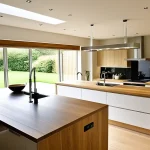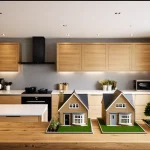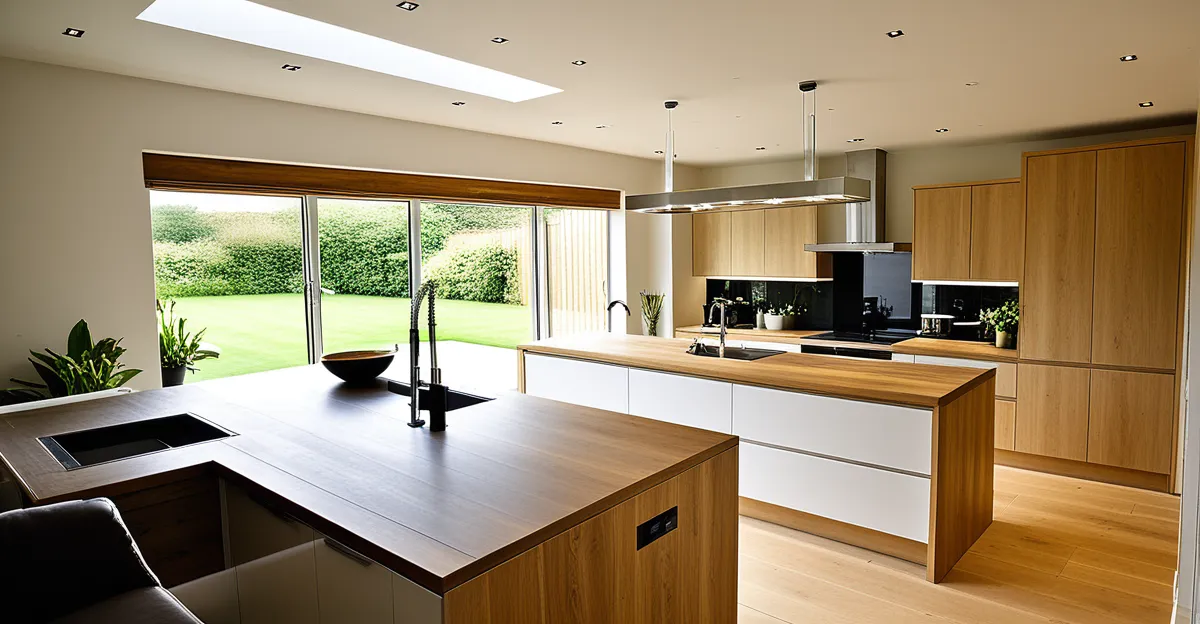The Relationship Between Home Design Choices and Sustainable Living in the UK
Small design decisions in UK homes profoundly affect both resource consumption and carbon footprints. Choosing eco-friendly home choices in the UK can drastically reduce energy use and waste, directly impacting sustainability. For example, opting for passive solar design or energy-efficient windows minimizes heating demand, lowering overall emissions.
Sustainable home design UK strategies focus on reducing environmental impact while enhancing comfort and long-term savings. The housing sector’s importance in achieving national carbon reduction goals is widely recognized. Houses consume significant energy for heating, lighting, and water use, making design a critical factor in addressing climate change.
Additional reading : What Are the Essential Elements for Creating a Cozy UK Home During Winter?
Current UK sustainability targets emphasize net-zero carbon emissions by 2050, pushing builders and homeowners toward more responsible choices. Government initiatives encourage environmentally conscious designs, supporting the uptake of renewable energy and water conservation. Integrating these measures into home design not only aligns with policy but also offers tangible benefits such as lower utility bills and increased property value.
In sum, the relationship between home design and sustainability represents a vital opportunity for the UK to meet its energy and environmental goals while improving everyday living standards.
Topic to read : What are the latest UK home renovation tax incentives?
Core Principles of Sustainable Home Design
Advanced insulation is a cornerstone in sustainable home design principles. By enhancing thermal efficiency, insulation reduces heat loss, cutting energy consumption for heating and cooling. In the UK’s often chilly climate, proper insulation directly lessens a home’s carbon footprint and utility costs. Techniques include insulated walls, roofs, and floors using materials like cellulose or mineral wool, which are both effective and sustainable.
Selecting environmentally responsible building materials also shapes sustainable home design UK. Low-impact options such as reclaimed wood, recycled metal, and low-VOC paints reduce resource extraction and indoor pollution. Sustainable building materials often possess longevity and require less maintenance, increasing a home’s eco credentials without compromising durability.
Energy efficiency UK measures in home layout and systems further amplify sustainability. Designing homes with optimal orientation for natural light, incorporating energy-efficient windows, and employing smart heating controls ensures energy use is minimized. Such strategies work collectively, aligning with sustainable home design principles to create comfortable, efficient living spaces that support the UK’s environmental targets.
The Relationship Between Home Design Choices and Sustainable Living in the UK
Small but deliberate eco-friendly home choices UK shape energy consumption and the overall carbon footprint. How does this happen? Design decisions, such as the placement of windows or choice of ventilation, directly influence heating, cooling, and lighting demands. A well-positioned home can reduce the need for artificial heating, cutting down resource use significantly.
Why is this important? The UK’s housing sector accounts for a large proportion of national energy consumption, making sustainable home design UK a priority to meet climate targets. Current UK sustainability targets, including reaching net-zero carbon emissions by 2050, place pressure on builders and homeowners alike to implement greener solutions.
Government initiatives further promote these eco-friendly home choices UK by offering guidance and support for adopting renewable energy and water-saving technologies. Together, these efforts highlight the crucial impact of home design on sustainability. Thoughtful design choices ensure that homes are not only more cost-effective but also contribute meaningfully to the country’s environmental goals.
The Relationship Between Home Design Choices and Sustainable Living in the UK
How do home design choices affect sustainability? The impact of home design on sustainability is substantial because each design decision directly shapes resource consumption and a home’s carbon footprint. For example, window placement alters natural light and ventilation, which can reduce reliance on artificial heating and cooling. Similarly, choices about materials and building orientation influence energy needs, making eco-friendly home choices UK essential for lowering emissions.
Why does sustainability matter specifically in the UK housing sector? Homes in the UK significantly contribute to national energy use, particularly through heating and electricity. Therefore, sustainable home design UK is crucial to meet environmental targets.
What targets and initiatives guide these choices? The UK aims for net-zero carbon emissions by 2050, prompting policies encouraging greener building practices. Government programs support implementing renewable technologies and energy-efficient solutions. These initiatives make eco-friendly home choices UK both a social responsibility and a practical strategy to save costs while aiding climate goals.
The Relationship Between Home Design Choices and Sustainable Living in the UK
How do design decisions directly influence resource consumption and carbon footprint? Each element of a home’s design—from orientation to materials—dictates energy use. For instance, strategic window placement enhances natural light and ventilation, reducing dependency on artificial heating and cooling. Similarly, selecting appropriate building materials impacts thermal retention and longevity, further controlling energy demand. These eco-friendly home choices UK collectively lower a household’s carbon footprint by optimizing energy efficiency and resource use.
Why is sustainability especially critical in the UK housing sector? The UK’s homes consume a notable proportion of national energy, mainly from heating. Therefore, adopting sustainable home design UK methods tackles one of the largest contributors to carbon emissions. Reducing energy consumption in residences thus plays a pivotal role in achieving wider environmental goals.
What guides these efforts? The UK government’s commitment to net-zero carbon emissions by 2050 fosters policies promoting greener building practices. Initiatives support installing renewable technologies and incentivize energy-efficient upgrades. These frameworks empower homeowners and builders to make more responsible, eco-friendly design choices, ensuring sustainability remains a national priority.
The Relationship Between Home Design Choices and Sustainable Living in the UK
How do design decisions directly influence resource consumption and carbon footprint? Each choice in a home’s design substantially shapes its energy demand and emissions. For example, eco-friendly home choices UK—such as orienting a home to maximize natural light—reduce reliance on artificial lighting and heating. Similarly, using materials with high thermal mass helps regulate indoor temperatures, lowering energy needed for heating or cooling. Collectively, these factors determine the overall carbon footprint, making sustainable home design UK not just beneficial but essential.
Why is sustainability especially important in the UK housing sector? UK homes account for a large share of national energy use, predominantly for heating. This consumption generates significant carbon emissions, so where and how energy is used becomes a focal point for reduction efforts. By integrating sustainable home design UK concepts early, households directly lower energy consumption and contribute to national goals.
What frameworks guide these changes? The UK government’s ambitious target for net-zero carbon emissions by 2050 drives regulations and initiatives promoting greener building practices. Support programs encourage the adoption of renewable energy systems and energy-efficient solutions, enabling homeowners to make informed, impactful eco-friendly home choices UK.











